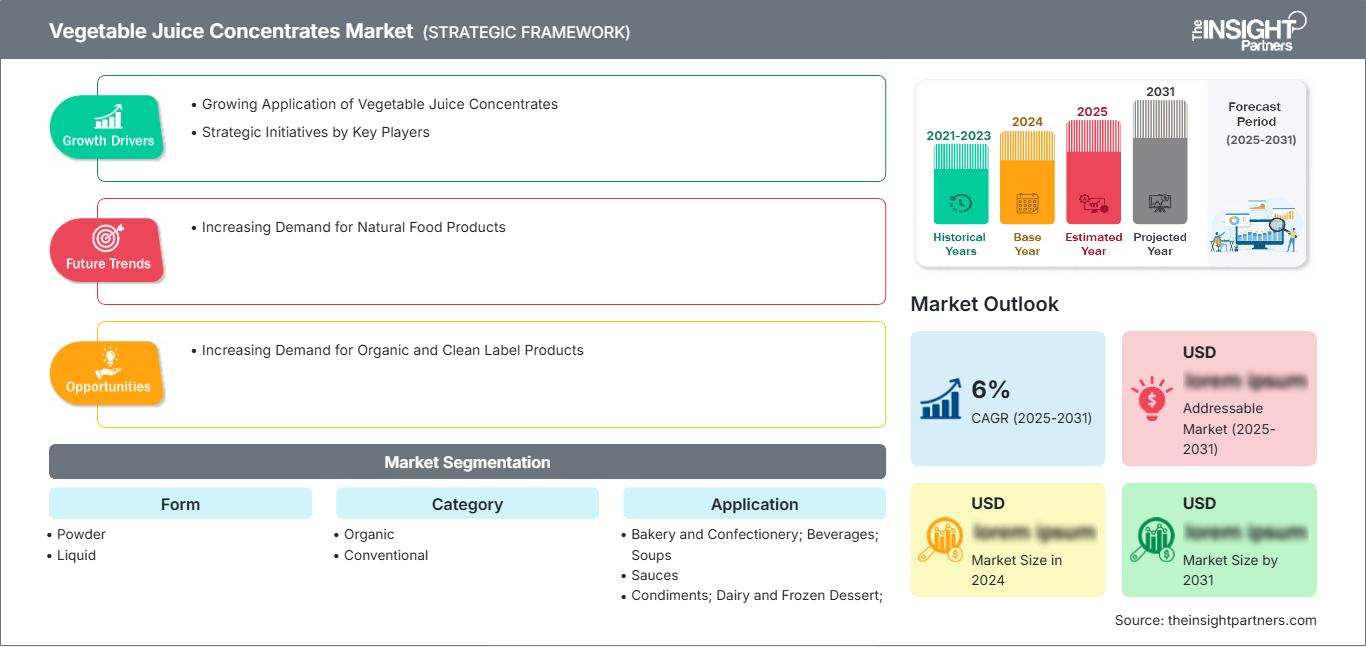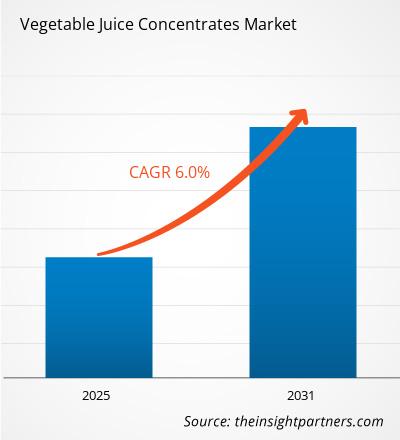Der Markt für Gemüsesaftkonzentrate wird zwischen 2023 und 2031 voraussichtlich eine durchschnittliche jährliche Wachstumsrate (CAGR) von 6 % verzeichnen. Die steigende Nachfrage nach Bio- und Clean-Label-Produkten dürfte der Trend auf dem Markt für Gemüsesaftkonzentrate sein.
Marktanalyse für Gemüsesaftkonzentrate:
- Der Markt für Gemüsesaftkonzentrate verzeichnet aufgrund der steigenden Verbrauchernachfrage nach gesunden und praktischen Getränken ein stetiges Wachstum. Zu den wichtigsten Antriebsfaktoren zählen der gesunde Lebensstil der Verbraucher, das schnelle Lebenstempo und die Verwendung von Konzentraten in vielen Arten von Lebensmitteln und Getränken.
- Marktteilnehmer achten auf Produktinnovationen und folgen dem neuesten Trend, ihren Kundengruppen besonders natürliche und biologische Produkte vorzustellen. Die Region Asien-Pazifik wird im Prognosezeitraum aufgrund der am schnellsten wachsenden Urbanisierung und der Verbesserung der Ernährungsgewohnheiten den höchsten Marktanteil verzeichnen.
Marktübersicht Gemüsesaftkonzentrate
- Gemüsesaftkonzentrate sind Gemüsesäfte, denen der größte Teil des Wassers entzogen wurde. Je nach verwendeter Gemüsesorte enthalten sie wichtige Nährstoffe wie Mineralien und Vitamine.
- Gemüsesaftkonzentrate sind im Vergleich zu Rohsäften stark verarbeitet. Der Wasserentzug in Saftkonzentraten hilft, das Bakterienwachstum zu reduzieren. Sie werden in der Regel gefroren oder bei Raumtemperatur gelagert und vor dem Verzehr in gefiltertem Wasser verdünnt.
- Außerdem sind die Konzentrate reich an Vitamin C und anderen Antioxidantien, die die Hautgesundheit fördern und die Hautalterung verlangsamen. Sie werden von den Verbrauchern üblicherweise als gesunde Alternative zu frisch gepresstem Saft konsumiert.
Passen Sie diesen Bericht Ihren Anforderungen an
Sie erhalten kostenlos Anpassungen an jedem Bericht, einschließlich Teilen dieses Berichts oder einer Analyse auf Länderebene, eines Excel-Datenpakets sowie tolle Angebote und Rabatte für Start-ups und Universitäten.
Markt für Gemüsesaftkonzentrate: Strategische Einblicke

- Holen Sie sich die wichtigsten Markttrends aus diesem Bericht.Dieses KOSTENLOSE Beispiel umfasst Datenanalysen, die von Markttrends bis hin zu Schätzungen und Prognosen reichen.
Markttreiber und -chancen für Gemüsesaftkonzentrate: Zunehmende Anwendung von Gemüsesaftkonzentraten
Sie erhalten kostenlos Anpassungen an jedem Bericht, einschließlich Teilen dieses Berichts oder einer Analyse auf Länderebene, eines Excel-Datenpakets sowie tolle Angebote und Rabatte für Start-ups und Universitäten.
Markt für Gemüsesaftkonzentrate: Strategische Einblicke

- Holen Sie sich die wichtigsten Markttrends aus diesem Bericht.Dieses KOSTENLOSE Beispiel umfasst Datenanalysen, die von Markttrends bis hin zu Schätzungen und Prognosen reichen.
- In der Getränkeindustrie erfreuen sich diese Konzentrate zunehmender Beliebtheit in funktionellen Getränken und Smoothies, die sich als sichtbarer Trend im Konsumverhalten der Verbraucher auf den Weltmärkten abzeichnen, einfach wegen des Vorteils gebrauchsfertiger, praktischer Nahrung.
- Lebensmittelhersteller verwenden zunehmend Konzentrate aus Gemüse als natürliche Zusatzstoffe, um Geschmack und Farbe in Soßen, Suppen, Crackern, Snacks oder anderen Produkten zu verbessern. Mittlerweile geben Bäcker Gemüsekonzentrate für Geschmack und Farbe in alle Arten von Brot und anderen Backwaren, da die Verbraucher zunehmend Wert auf Etiketten ohne künstliche Zutaten legen.
- Zu den Nutraceuticals gehören Gemüsesaftkonzentrate, die Nahrungsergänzungsmitteln zugesetzt werden, damit die Verbraucher problemlos eine hohe Nährstoffkonzentration zu sich nehmen können. Konzentrate werden in ähnlicher Weise bei der Entwicklung von Fertiggerichten eingesetzt, um das Nährstoffprofil von Fertiggerichten für die zunehmende Zahl gesundheitsbewusster Verbraucher zu verbessern, die verpackte Produkte verlangen.
Steigende Nachfrage nach natürlichen Lebensmitteln
- Die steigende Nachfrage nach natürlichen Lebensmitteln hat mehrere Geschäftsmöglichkeiten geschaffen, eine davon sind Gemüsesaftkonzentrate. Verbraucher suchten zunehmend nach Lebensmitteln und Getränken mit Clean Label und minimal verarbeiteten Bestandteilen, was Hersteller dazu veranlasste, natürliche Zutaten zu verwenden.
- Gemüsesaftkonzentrate können eine natürliche Alternative zu künstlichen Zusatzstoffen darstellen und bringen somit zusätzliche Vorteile mit sich: Verbraucher fühlen sich oft von natürlichen Aromen, Farben und Nährstoffen angezogen, während Lebensmittel- und Getränkeunternehmen die von Verbrauchern nachgefragten natürlichen Produkte liefern können.
Marktsegmentierung für Gemüsesaftkonzentrate
Der Umfang des globalen Marktes für Gemüsesaftkonzentrate ist nach Form, Kategorie und Anwendung segmentiert.
- Auf Grundlage der Form ist der Markt in Pulver und Flüssigkeit segmentiert.
- Auf Grundlage der Kategorie ist der Markt in biologisch und konventionell segmentiert.
- Basierend auf der Anwendung ist der Markt für Gemüsesaftkonzentrate in Backwaren und Süßwaren, Getränke, Suppen, Soßen und Gewürze, Milchprodukte und gefrorene Desserts sowie und andere.
Marktanteilsanalyse für Gemüsesaftkonzentrate nach geografischer Lage
- Der Marktbericht für Gemüsesaftkonzentrate enthält eine detaillierte Analyse der fünf wichtigsten geografischen Regionen, einschließlich der aktuellen und historischen Marktgröße sowie Prognosen für 2021 bis 2031 für Nordamerika, Europa, den asiatisch-pazifischen Raum (APAC), den Nahen Osten und Afrika (MEA) sowie Süd- und Mittelamerika.
- Jede Region ist weiter in entsprechende Länder unterteilt. Dieser Bericht bietet Analysen und Prognosen für mehr als 18 Länder und deckt die Marktdynamik für Gemüsesaftkonzentrate ab, darunter Treiber, Trends und Chancen, die die Märkte auf regionaler Ebene beeinflussen.
- Darüber hinaus umfasst der Bericht die Fünf-Kräfte-Analyse von Porter, die die Untersuchung der wichtigsten Faktoren umfasst, die den Markt für Gemüsesaftkonzentrate in diesen Regionen beeinflussen.
Markt für Gemüsesaftkonzentrate
Die Analysten von The Insight Partners haben die regionalen Trends und Faktoren, die den Markt für Gemüsesaftkonzentrate im Prognosezeitraum beeinflussen, ausführlich erläutert. In diesem Abschnitt werden auch die Marktsegmente und die geografische Lage von Gemüsesaftkonzentraten in Nordamerika, Europa, im asiatisch-pazifischen Raum, im Nahen Osten und Afrika sowie in Süd- und Mittelamerika erläutert.Umfang des Marktberichts über Gemüsesaftkonzentrate
| Berichtsattribut | Einzelheiten |
|---|---|
| Marktgröße in 2024 | US$ XX million |
| Marktgröße nach 2031 | US$ XX Million |
| Globale CAGR (2025 - 2031) | 6% |
| Historische Daten | 2021-2023 |
| Prognosezeitraum | 2025-2031 |
| Abgedeckte Segmente |
By Form
|
| Abgedeckte Regionen und Länder | Nordamerika
|
| Marktführer und wichtige Unternehmensprofile |
|
Marktteilnehmerdichte für Gemüsesaftkonzentrate: Auswirkungen auf die Geschäftsdynamik verstehen
Der Markt für Gemüsesaftkonzentrate wächst rasant. Die steigende Nachfrage der Endverbraucher ist auf Faktoren wie veränderte Verbraucherpräferenzen, technologische Fortschritte und ein stärkeres Bewusstsein für die Produktvorteile zurückzuführen. Mit der steigenden Nachfrage erweitern Unternehmen ihr Angebot, entwickeln Innovationen, um den Bedürfnissen der Verbraucher gerecht zu werden, und nutzen neue Trends, was das Marktwachstum weiter ankurbelt.
- Holen Sie sich die Markt für Gemüsesaftkonzentrate Übersicht der wichtigsten Akteure
Der Markt für Gemüsesaftkonzentrate wird durch die Erhebung qualitativer und quantitativer Daten aus Primär- und Sekundärforschung bewertet, die wichtige Unternehmenspublikationen, Verbandsdaten und Datenbanken umfasst. Im Folgenden finden Sie eine Liste der Entwicklungen auf dem Markt für Innovationen, Geschäftserweiterungen und Strategien:
- Austria Juice präsentierte auf der BioFach 2023 seine neuesten Bio-Saftkonzentrate und -mischungen, darunter einen neuen Granatapfel-Beeren-Mix und ein Limetten-Guave-Getränk. FoodIngredientsFirst sprach mit Kai Oliver Antonius, Vorstandsmitglied und CSO für Mehrwert bei Austria Juice. (Quelle: Newsletter, Artikel, Februar 2023)
Marktbericht zu Gemüsesaftkonzentraten: Abdeckung und Ergebnisse
Der Bericht „Marktgröße und Prognose für Gemüsesaftkonzentrate (2021 – 2031)“ bietet eine detaillierte Analyse des Marktes in den folgenden Bereichen:
- Marktgröße und Prognose für Gemüsesaftkonzentrate auf globaler, regionaler und Länderebene für alle abgedeckten wichtigen Marktsegmente
- Markttrends für Gemüsesaftkonzentrate sowie Marktdynamik wie Treiber, Einschränkungen und wichtige Chancen
- Detaillierte PEST/Porters Five Forces- und SWOT-Analyse
- Marktanalyse für Gemüsesaftkonzentrate mit wichtigen Markttrends, globalen und regionalen Rahmenbedingungen, wichtigen Akteuren, Vorschriften und aktuellen Marktentwicklungen
- Branchenlandschaft und Wettbewerbsanalyse mit Marktkonzentration, Heatmap-Analyse, prominenten Akteuren und aktuellen Entwicklungen bei Gemüsesaftkonzentraten Markt
- Detaillierte Unternehmensprofile
- Historische Analyse (2 Jahre), Basisjahr, Prognose (7 Jahre) mit CAGR
- PEST- und SWOT-Analyse
- Marktgröße Wert/Volumen – Global, Regional, Land
- Branchen- und Wettbewerbslandschaft
- Excel-Datensatz
Aktuelle Berichte
Erfahrungsberichte
Grund zum Kauf
- Fundierte Entscheidungsfindung
- Marktdynamik verstehen
- Wettbewerbsanalyse
- Kundeneinblicke
- Marktprognosen
- Risikominimierung
- Strategische Planung
- Investitionsbegründung
- Identifizierung neuer Märkte
- Verbesserung von Marketingstrategien
- Steigerung der Betriebseffizienz
- Anpassung an regulatorische Trends




















 Kostenlose Probe anfordern für - Markt für Gemüsesaftkonzentrate
Kostenlose Probe anfordern für - Markt für Gemüsesaftkonzentrate